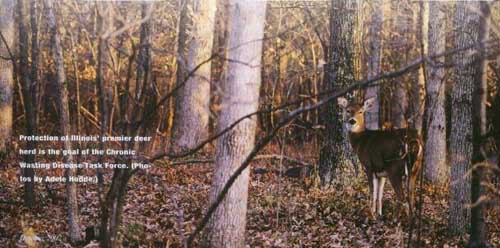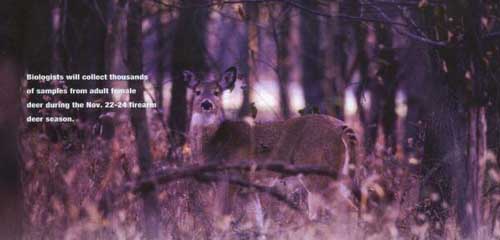 |
Home | Search | Browse | About IPO | Staff | Links |
 |
Home | Search | Browse | About IPO | Staff | Links |
|
Chronic Wasting Disease Ever since chronic wasting disease was discovered in the white-tailed deer population in Wisconsin, 40 miles from our northern border, hunters in Illinois have been asking themselves just what is this disease and is it something they need to worry about. CWD is not present in the Illinois deer herd that we are aware of. During the past five years we have tested wild deer reported to have signs similar to those caused by the disease. None have been positive for CWD. During the 2001 firearm season, we tested about 260 hunter-harvested deer from around the state. Still nothing. We are stepping up surveillance efforts, however. Our approach is this: We intend to take every step we believe to have scientific merit to stop this disease from coming into Illinois. We have the premier deer herd in the country, and we believe it is worth protecting. A task force, comprised of key staff from the departments of Natural Resources and Agriculture, has been developing plans to address surveillance of wild deer and captive herds, import and export of deer and elk and a planned response to a potential CWD outbreak in Illinois. There are many unknowns regarding this disease, but let's go through some of the information that we do know—and information you need to know—to be informed about CWD. What is chronic wasting disease? Chronic wasting disease is a disease of the nervous system, which includes the brain, spinal cord and nerves. It is found in deer and elk, and it is always, eventually fatal. You may have heard of other diseases similar to CWD such as Creutzfeldt-Jakob Disease, which impacts humans; mad cow disease, which impacts cows; or scrapie which impacts sheep and goats. While they have similar features, they are not the same disease. What would I notice about a deer that had CWD? The disease attacks the brain of infected animals. They become very thin, display abnormal behavior and lose coordination. Signs of the disease include excessive salivation, loss of appetite, progressive weight loss, excessive thirst and urination, listlessness, teeth grinding, holding the head in a lowered position and drooping ears. Deer with these signs don't necessarily have CWD. Many of these signs can also be caused by other diseases. Since CWD is a slowly progressive disease, signs usually are not seen until the animal is 18 months of age or older. Where did CWD come from? The origin of CWD is not known. While it has only recently come to the attention of Illinois hunters, it is not a


new disease. The illness was first noticed in captive mule deer in Colorado in the 1960s, although its cause was unknown. It was a decade later before researchers discovered that the symptoms of CWD resulted from a degenerative nervous disorder, with spongelike holes forming in the brain much like the sheep disease scrapie. During the 1980s and early 1990s, CWD is believed to have been limited to Colorado and Wyoming. That's not the case anymore. CWD has been diagnosed in wild, free-ranging deer and/or elk in Colorado, Wyoming, Nebraska, South Dakota, Wisconsin, New Mexico and Saskatchewan. CWD also has been found in captive elk in Colorado, Kansas, Minnesota, Montana, Nebraska, Oklahoma, South Dakota, Wyoming, Alberta and Saskatchewan.
How the disease spreads from one deer to another is not completely understood. It is thought that the disease can be passed between animals in a herd and also perhaps from mother to offspring. It is not easy to eliminate through heat or disinfection, and transmission from a contaminated environment appears to be possible. Hunting season is upon us. What can I expect? New rules are in place. If you hunt deer and elk in other states, you may transport only the following into Illinois: deboned meat, antlers, antlers attached to skull caps, hides, upper canine teeth and finished taxidermy mounts. Skull caps must be cleaned of all brain and muscle tissue. This is intended to prevent hunters from bringing in potentially diseased animals and discarding their parts in a manner that could contaminate Illinois' deer herd. The feeding of wild deer and other wildlife in areas where deer are present is no longer allowed. The ban includes food, salt, mineral blocks and other food products, with some exceptions. For example, bird and squirrel feeders close to homes and incidental feeding of wildlife within active livestock operations are allowed. Wildlife food plots are allowed, but deer feeders and bait piles are not. While retail stores sell deer bait and it is legal to purchase it, it is no longer legal to use it in Illinois. Bait sites where deer congregate have the potential to spread CWD and other diseases. Eliminating this practice will increase our chances of controlling CWD in the event it enters Illinois. At the check station: The Department of Natural Resources is stepping up its surveillance efforts. Additional testing will be conducted in the most effective and efficient manner possible. During the first weekend of firearm deer season, Nov. 22-24, biologists will collect thousands of samples across the state. Samples won't be collected from every deer, nor will samples be taken at every check station. Samples will not be taken from deer harvested during the archery season. The test for CWD requires a sample from a specific portion of the brain, certain lymph nodes or the tonsils, so biologists will collect the entire head of the animals they are sampling. Samples from adult female deer only will be taken because the disease doesn't favor one sex or the other and it is easier to transport an antlerless head. OutdoorIlliois 16
Biologists will also collect information such as the age and sex of the deer and the county where it was taken. Should a sample test positive, the hunter will be notified. Please note, however, that it could take several months before test results are returned to the Department. YOUR PARTICIPATION IS VOLUNTARY. You can decline to have the animal you harvested tested. You should be aware that there is no reliable test of live animals in use. There also is no test that you can purchase for you or your meat processor to test your animal. Sampling also is being done in the Chicago metropolitan area where firearm deer hunting is not allowed. At the meat processor: The American Association of Meat Processors has developed recommendations for its members regarding the handling of deer and elk. Although there is no documented risk to humans from CWD, following their guidelines should further help address concerns related to the disease. These guidelines include recommendations for increased boneless processing, in order to minimize contact with nerve tissue. Use a reputable professional processor—a conscientious hunter takes the time to properly field dress and care for his/her animal, and should expect that same level of care at the processor. Hunters should be aware that preparation of burger and specialty sausages is normally achieved by "batching" multiple animals, in case they want to avoid this situation.
In the kitchen/at the dinner table: Though CWD has been in the United States for decades, there has never been an instance of people contracting the disease from butchering or eating meat from CWD-infected animals. A World Health Organization panel of experts reviewed all available information on CWD and concluded that there is no scientific evidence that CWD can infect humans. However, there is much that scientists still do not know about CWD, and we cannot state that transmission of CWD to humans is absolutely not possible. The disease seems to concentrate in certain parts of infected animals—the brain, eyes, spinal cord, lymph nodes, tonsils and spleen—so, these tissues should not be eaten. (Normal field dressing coupled with boning out of a carcass will remove essentially all of these parts.) As a precaution, health officials additionally advise that no part of any animal with evidence of CWD should be consumed by humans or other animals. As with anything new, there are all kinds of rumors. There's the fear of the unknown. Rest assured, we will tell you what we know as we learn it. For the most up-to-date information during the hunting season, please check the Department of Natural Resources website at http://dnr.state.il.us/pubaffairs/2002/CWD.htm. The information for this article was compiled by the Chronic Wasting Disease Task Force.
October 2002 17 |
|
State Library |